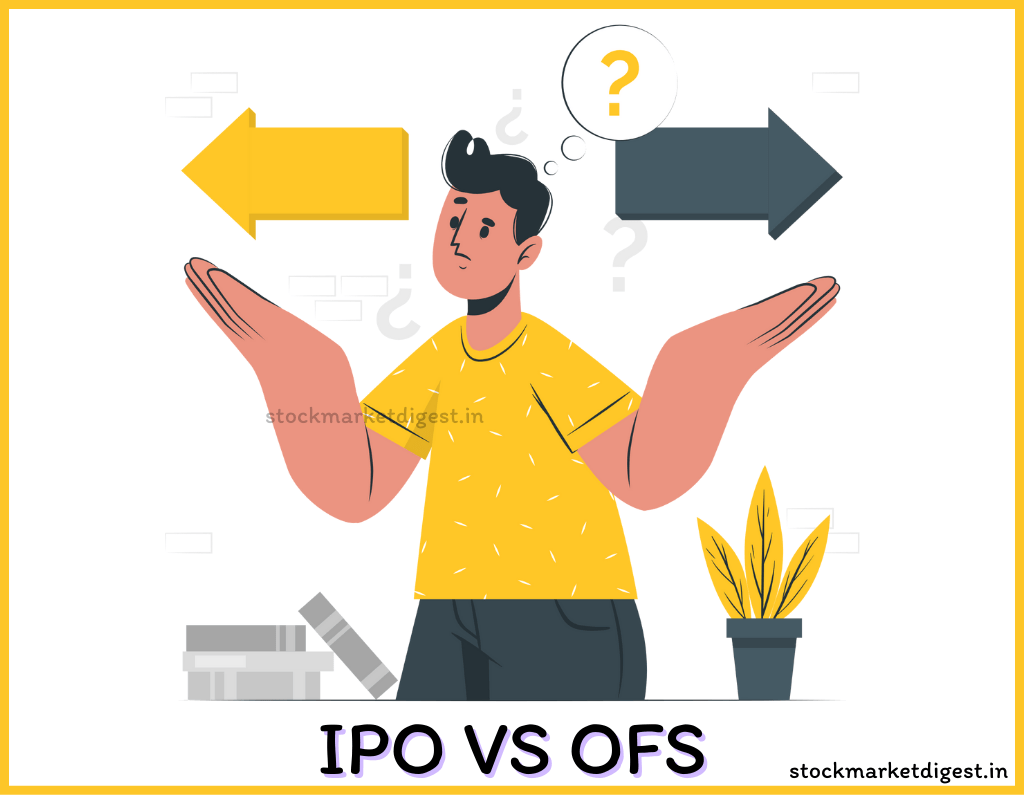In the stock market, you often hear about IPO (Initial Public Offering) and OFS (Offer for Sale). But what do these terms really mean for regular investors like us?.
In this article, let’s break down the difference between IPO Vs OFS in simple terms.

Understanding IPO (Initial Public Offering):
An IPO is a way for a private company to become public by selling its shares to the public. It’s like the company’s big debut on the stock market.
In an IPO, the company offers its shares to anyone interested in buying them, and investors who purchase these shares become owners of a piece of the company.
The main goal of an IPO is for the company to raise funds for things like expanding their business or paying off debts.
IPOs are often used by smaller companies that are still growing and want more people to invest in them, making it a significant step in a company’s financial journey.
Also Read : What is IPO Cycle and What are various stages of it – in detail
How Does IPO Work?
The process of how an IPO works is quite straightforward. First, a private company decides it wants to become public, and it selects banks to help with the process.
These banks assist in setting the share price and ensuring everything follows the rules. The company then shares detailed information, like its finances, in a document called a prospectus.
Once regulators approve this document, the company goes on a roadshow to present its business to potential investors.
After this, shares are allotted, and they become available for trading on the stock exchange. In simple terms, an IPO allows a private company to share ownership with the public while raising money for its future plans.
There are two types of IPOs: Fixed Price Issue and Book-Building Issue, each with its own approach to determining share prices.
Benefits of IPO Investing:
Investing in an IPO comes with several advantages. Firstly, investors become shareholders, meaning they own a part of the company.
This ownership can lead to receiving dividends and bonuses. Secondly, the shares bought during an IPO can be freely traded, providing increased liquidity.
Additionally, IPOs offer a chance for investors to diversify their investment portfolios by putting money into multiple ventures.
Overall, IPO investing is a way for individuals to support a company’s growth while potentially benefiting from its success, making it an attractive option for those seeking ownership in promising businesses and the possibility of financial returns.
Understanding OFS (Offer for Sale):
OFS, or Offer For Sale is a straightforward method where existing shareholders, like company promoters, sell their shares in the secondary market.
Unlike an IPO, the funds raised from OFS go directly to the selling shareholders rather than the company. This process allows those holding more than 10% of a company’s shares to sell their stock through the stock exchange platform.
Introduced by SEBI in 2012, OFS gained popularity, providing a way for promoters to reduce their holding shares.
It’s a cost-effective investment option with minimal paperwork, offering benefits like potential reductions in market prices and rebates for retail buyers, making it an appealing choice for investors.
How Does OFS Work?
In OFS, existing share holders such as promoters or owners of a company can sell their shares through the stock exchange platform.
Anyone, including retail investors, can bid for these shares. The company sets a floor price, and buyers cannot bid below this price.
During the bid-placing process, shares are immediately allocated to the respective buyers. Unlike an IPO, OFS shares are sold in bundles, so investors need to place bids for multiple shares.
This cost-effective method involves minimal paperwork and can offer reductions in market prices, making it an attractive and accessible option for various types of investors.
Benefits of OFS:
Investing through OFS carries several advantages.
Firstly, it is a cost-effective method as it involves minimal additional charges beyond basic transactional fees and taxes. The application process is mostly online, simplifying paperwork for investors.
Eligible buyers can enjoy a potential reduction in the market price of stocks purchased through OFS. Retail investors often receive rebates of up to 5% on the stock price.
Additionally, due to its one-operational day feature, OFS is less time-consuming for the issuing company.
Overall, OFS presents a convenient and accessible way for investors to participate in the stock market with reduced costs and simplified procedures, making it an appealing option for various investors.
IPO vs. OFS – The Key Differences:
The difference between IPO and OFS is provided below for clear understanding.
| Criteria | OFS | IPO |
|---|---|---|
| Purpose | Provides selling option for shareholders (>10% ownership), funds go to shareholders. | Raises capital for expansion, funds go to the company. |
| Formalities | No need for Red Herring Prospectus or formal paperwork. | Requires underwriting, preparation of prospectus, and filing with authorities. |
| Shareholder Distribution | 25% for mutual funds and insurance; 10% for retail investors. | Retail investors get 35% of issued shares. |
| Cost | Minimal cost involved. | Relatively more costly. |
| Duration | Generally one trading day. | Generally 3 to 10 trading days. |
| Risk | Market-driven, dependent on share movement. | Higher risk due to being an unlisted company. |
| Company Status | Listed company. | Unlisted company. |
Also Read : What is Lot Size and Minimum Order Quantinty (MOQ) in IPO
Conclusion:
Both IPO and OFS present attractive investment opportunities for different reasons. IPOs offer the first mover’s advantage, while OFS provides access to a company’s historical data supporting its market status.
However, caution is advised, and investors should thoroughly analyze the company before making any investment decision to minimize potential losses.
Understanding the fundamental differences between IPO and OFS is crucial for making informed investment choices in the stock market.
FAQs: IPO vs. OFS
Q1. What is an IPO?
Answer: An Initial Public Offering (IPO) is a process where a private company becomes public by offering its shares to the general public, aiming to raise capital for growth and expansion.
Q2. How does an IPO work?
Answer: The IPO process involves the company selecting underwriters, filing a prospectus with detailed financial information, going on an investor roadshow, and finally, listing on a stock exchange for public trading.
Q3. What are the benefits of investing in an IPO?
Answer: Investing in an IPO allows individuals to become shareholders, potentially receiving dividends, enjoying liquidity, and diversifying their investment portfolios.
Q4. What is OFS?
Answer: Offer for Sale (OFS) is a method where existing shareholders sell their shares in the secondary market, with the funds going directly to the selling shareholders, not the company.
Q5. How does OFS work?
Answer: In OFS, existing shareholders, including promoters, sell their shares through the stock exchange platform. Buyers bid for shares, and the selling shareholders receive the proceeds.
Q6. What are the benefits of investing in OFS?
Answer: Investing through OFS is cost-effective, involves minimal paperwork, offers potential reductions in market prices, and may provide rebates for retail buyers due to its one-operational day feature.
Q7. What are the key differences between IPO and OFS?
Answer: Differences include the purpose (capital raising in IPO vs. selling shares in OFS), formalities, shareholder distribution, cost, duration, risk, and the company’s status post-offering.
Q8. Which option should investors choose – IPO or OFS?
Answer: Both IPO and OFS offer attractive investment opportunities. Investors should carefully analyze the company, consider their goals, and weigh the associated risks before making a decision.
Check Out Below Articles Related to IPO:
- What is Face Value in IPO?: How it is Different From Issue Price
- What is IPO Lot Size and How It is Calculated?
- Is PAN Card Mandatory for Applying to an IPO?
- How to Apply for an IPO in Minors’s Name – Benefits and Tax Implications
- What is an Oversubscribed IPO and Its Effects?
- Price Band in IPOs: How It is decided?
- How to Apply for an IPO Through UPI – In 7 Easy Steps
- What is IPO Listing Gain? – Factors Influencing Listing Gain
- Syndicate Member: Role in IPO, Types and Syndication Risk
- What is a Shelf Prospectus, Criteria and How Can it Benefit an Investor?
- 15 Step Guide on How to Analyse an IPO
- What are the Difference Between Direct Listing and IPO?
- Difference Between Equity IPO and Debt IPO
- What is Flipping in IPO? – Explained With an Example
- What Happens if IPO is Underscribed? – Benefits and Drawbacks

